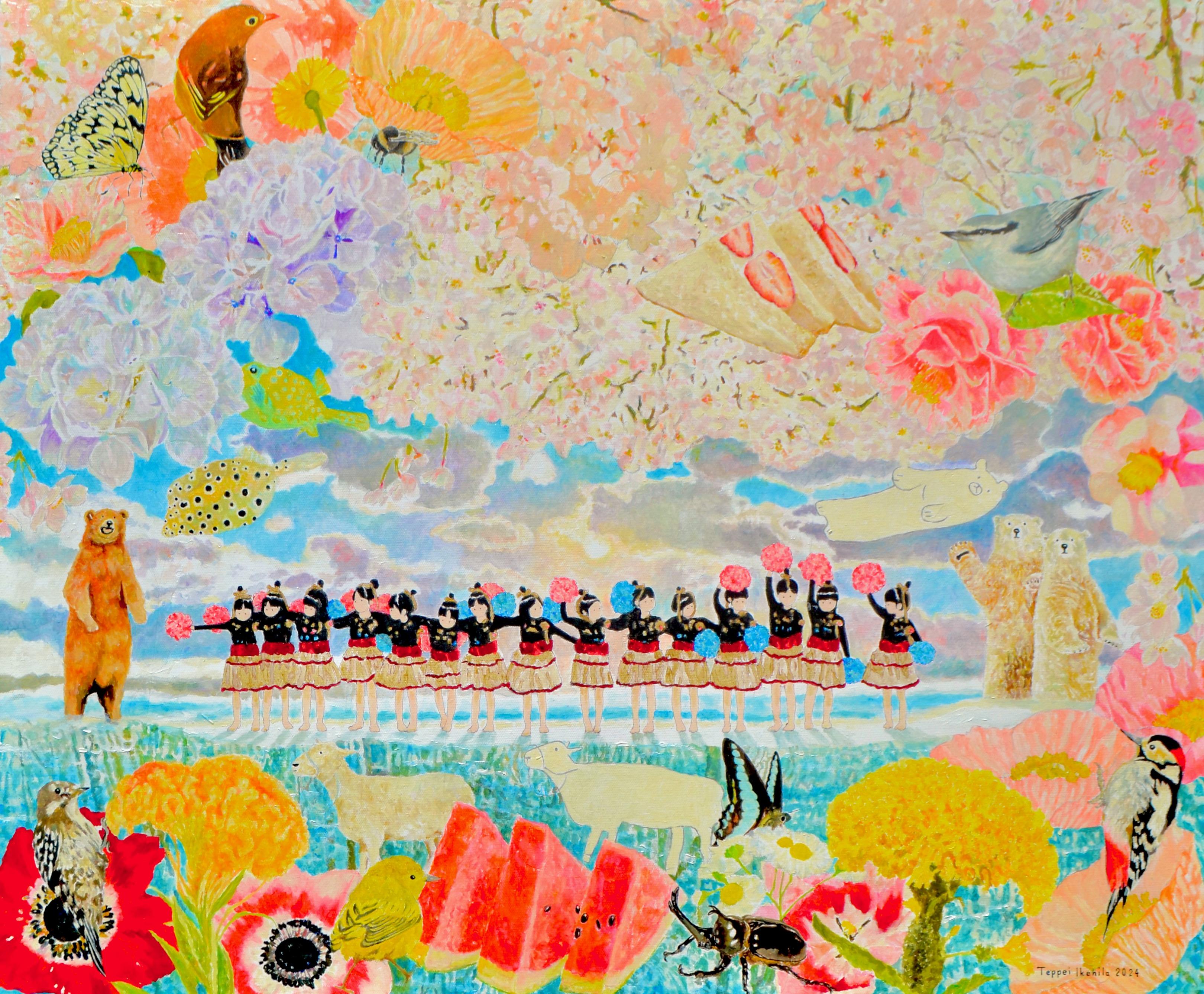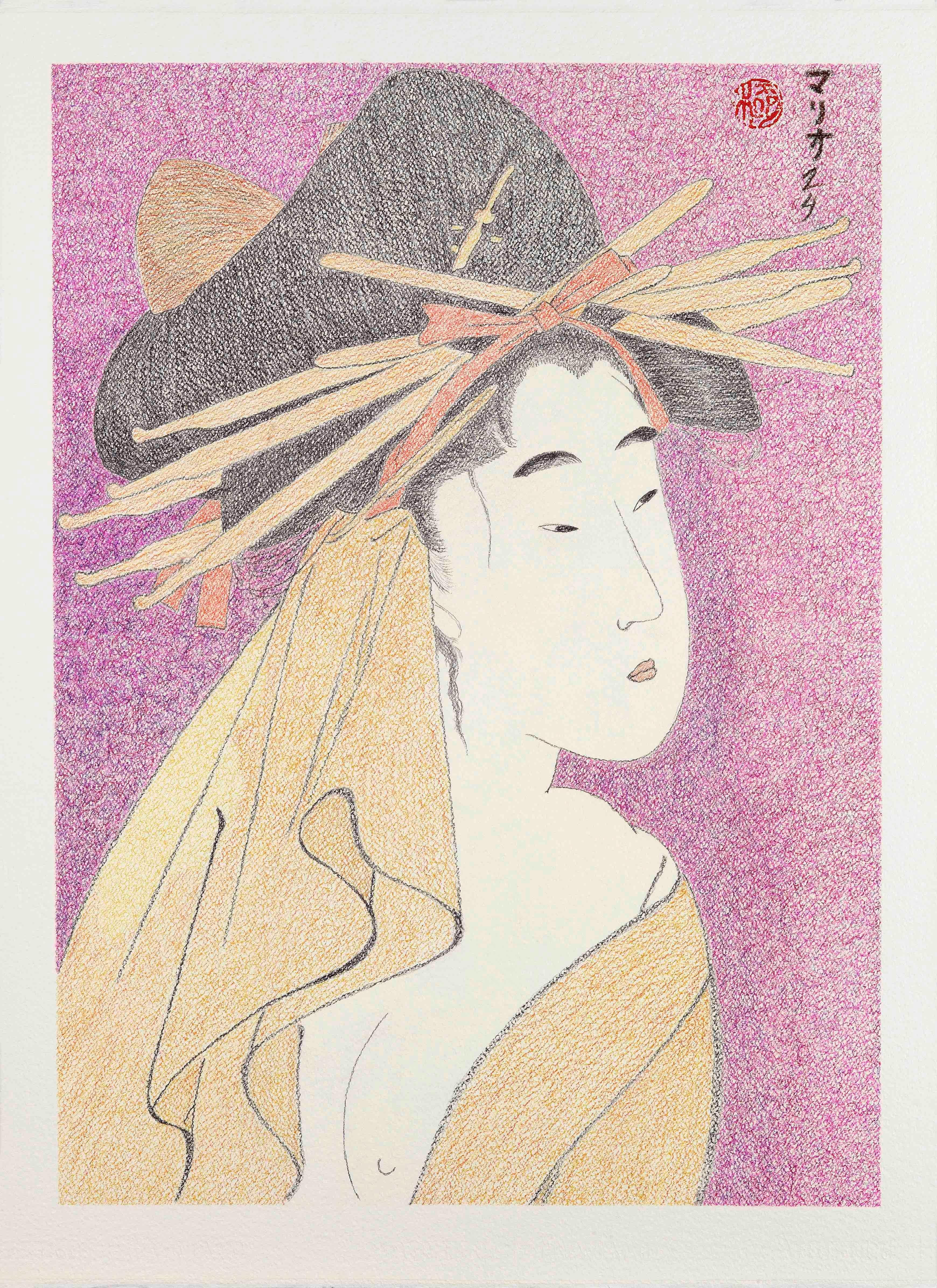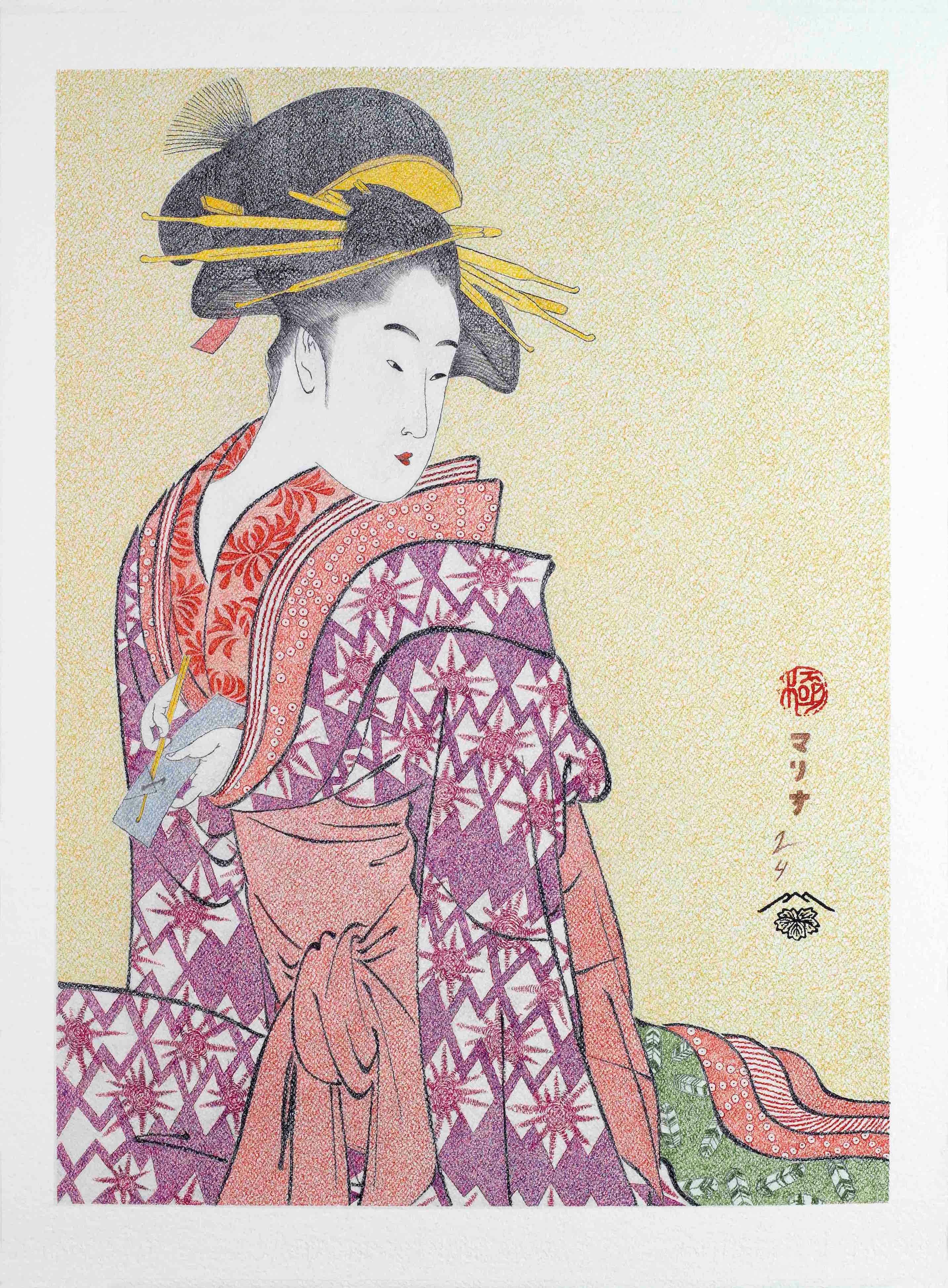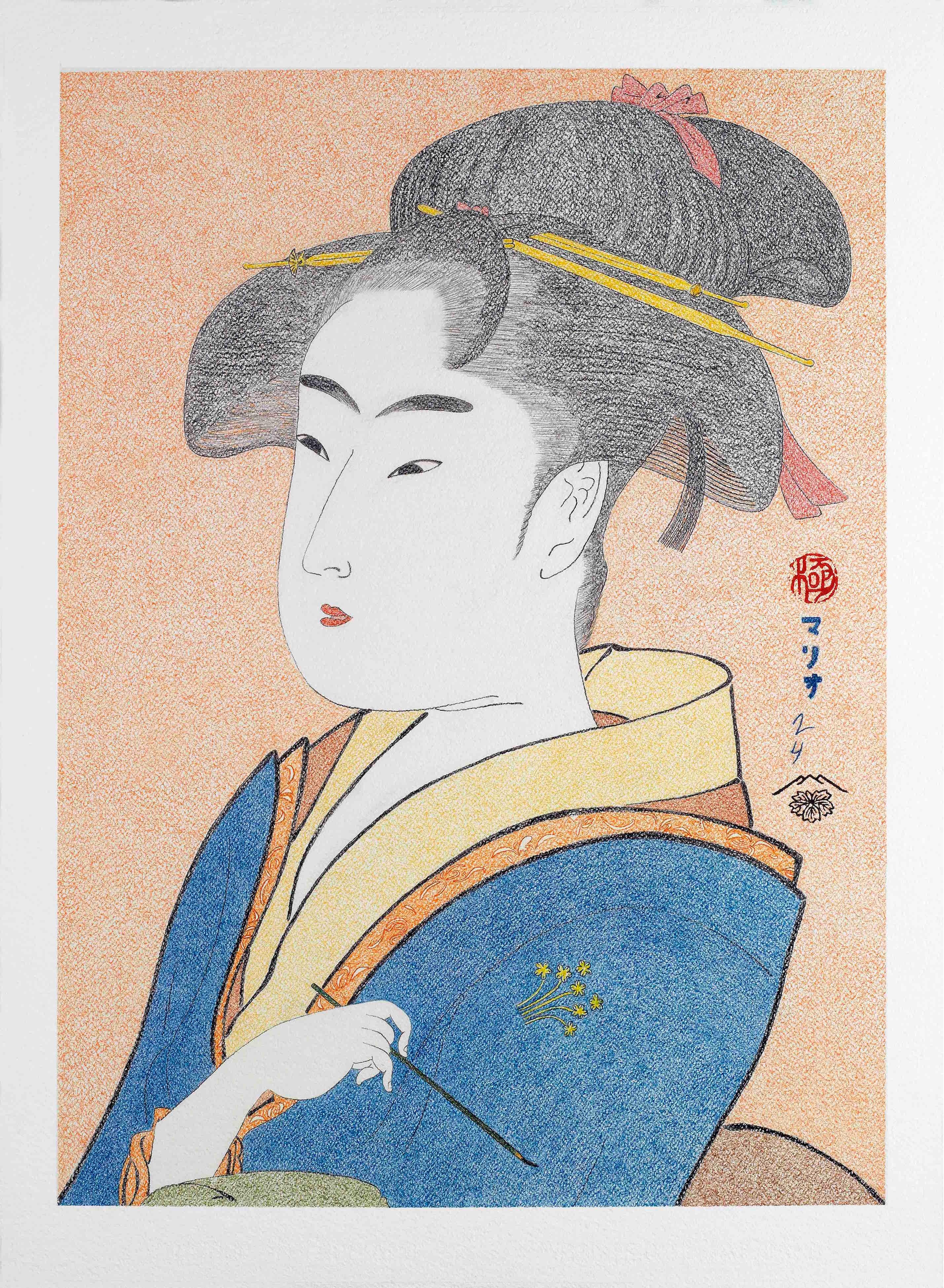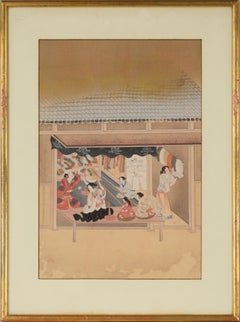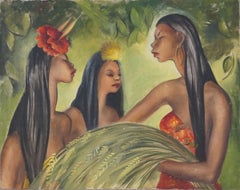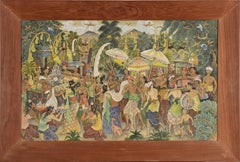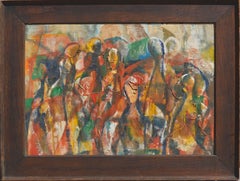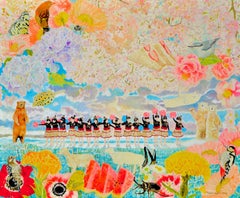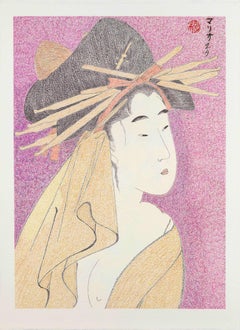Items Similar to Traditional Celebration and Costumes Japan or Okinawa
Want more images or videos?
Request additional images or videos from the seller
1 of 9
UnknownTraditional Celebration and Costumes Japan or Okinawa1990s
1990s
$1,150
£863.91
€996.23
CA$1,595.78
A$1,773.26
CHF 929.21
MX$21,745.85
NOK 11,851.48
SEK 11,149.44
DKK 7,435.45
Shipping
Retrieving quote...The 1stDibs Promise:
Authenticity Guarantee,
Money-Back Guarantee,
24-Hour Cancellation
About the Item
Traditional Celebration and Costumes Japan or Okinawa
Oil painting on illustration board of Japanese Ryukyu or Okinawa Island festival goers by and unknown artist.
Elegantly dressed villagers with canopies and Hats. Floral Kimonos with traditional waist and Head bands. Full of colors and details and lush surroundings.
Image, 23.75"H x 58.75"W
Frame, 2"H x 60"W x 1"D
Signed lower right, resembles Cyrillic characters.
- Creation Year:1990s
- Dimensions:Height: 24 in (60.96 cm)Width: 60 in (152.4 cm)Depth: 1 in (2.54 cm)
- Medium:
- Movement & Style:
- Period:
- Condition:Very good. Aluminum gold toned frame included as-is.
- Gallery Location:Soquel, CA
- Reference Number:Seller: RJA90381stDibs: LU54214186422
About the Seller
5.0
Platinum Seller
Premium sellers with a 4.7+ rating and 24-hour response times
Established in 1986
1stDibs seller since 2014
2,955 sales on 1stDibs
Typical response time: <1 hour
- ShippingRetrieving quote...Shipping from: Soquel, CA
- Return Policy
Authenticity Guarantee
In the unlikely event there’s an issue with an item’s authenticity, contact us within 1 year for a full refund. DetailsMoney-Back Guarantee
If your item is not as described, is damaged in transit, or does not arrive, contact us within 7 days for a full refund. Details24-Hour Cancellation
You have a 24-hour grace period in which to reconsider your purchase, with no questions asked.Vetted Professional Sellers
Our world-class sellers must adhere to strict standards for service and quality, maintaining the integrity of our listings.Price-Match Guarantee
If you find that a seller listed the same item for a lower price elsewhere, we’ll match it.Trusted Global Delivery
Our best-in-class carrier network provides specialized shipping options worldwide, including custom delivery.More From This Seller
View AllJapanese Artisans - Silk Dying -Japanese Woodblock Print
By Tosa Mitsuyoshi
Located in Soquel, CA
Japanese Artisans - Japanese Woodblock Print J
Japanese woodblock depicting six women, all wearing vibrant kimonos, working on crafts by Tosa Mitsuoki (Japanese, 1617-1691). Japanese,c. 1600. Handcraft depiction (dye works).Section from a painted screen with presentations of handcraft.Kita-in, Saitama.
Stamped lower left.
Presented in a white mat and giltwood frame.
Frame: 19"H x 14"W
Mat: 18.25"H x 13.25"W
Image: 14.5"H x 9.5"W
Tosa Mitsuoki was a Japanese painter, reinvigorating the Yamato style of classical Japanese painting. Yamato-e originated from interest in reproducing early Tang dynasty paintings, and was later reinvented and further refined to fit Japanese cultural perceptions in the late Heian period. Yamato, sometimes referred to as wa or kazu had become synonymous with the Tosa-ha by the Muromachi period as a way for Japanese artist to distinguish their works from those of mainland Chinese paintings, kara-e. Yamato-e incorporated various visual and literary techniques for establishing narrative. Works were not always accompanied with text and may rely on heavily on period specific visual motifs, icons, and symbols to relay a story or theme. Tosa style by the time of Mitsuoki focused heavily on depicting themes of plants and nature, famous places, meisho, the four seasons, shik, bird-and-flower, kacho. Many of these popular symbols and icons from mimicking Chinese practices, treating the original Chinese masterwork as a sort of prototype to improve upon. Popular formats for Mitsuoki's pictures were wall scrolls kakemono, or handscrolls that would be read from right to left with the accompanied story, sliding doors fusuma and folding screen panels byobu that featured up to six panels. Mitsuoki's style incorporated the depth and calligraphy techniques of ink wash brushwork similar to Song dynasty and Yuan dynasty Chinese court paintings...
Category
1920s Edo Landscape Paintings
Materials
Paper, Ink, Woodcut
Vintage Hawaiian Figurative Oil Painting -- Before The Luau
Located in Soquel, CA
1970's Original Hawaiian Figurative Oil Painting - Before the Luau
Colorful figurative of three Hawaiian women as they prepare for a Luau, circa 1970. The lush tropical backdrop fra...
Category
1970s Contemporary Figurative Paintings
Materials
Canvas, Oil, Stretcher Bars
Bali Jungle Village Procession, Indonesian Figural
Located in Soquel, CA
Lively and detailed depiction of a procession of Balinese figures in the Ubud regional style (Cremation Ceremony) by I Dewa Putu Sugi (Indonesian, b. 1931). ...
Category
Mid-20th Century Folk Art Figurative Paintings
Materials
Canvas, Acrylic
$1,625 Sale Price
24% Off
San Francisco Market Street in Style of Nathan Oliveria
Located in Soquel, CA
Wonderful Bay Area Figurative by unknown artist (signature marred), circa 1955. In style of Nathan Oliveria and Norman Bluhm. Image size 16"H x 23"W. Presented in rustic frame. Frame...
Category
1950s Modern Figurative Paintings
Materials
Oil, Laid Paper
Festival Procession Of A Daimyo - Original Woodblock Print
Located in Soquel, CA
Procession Of A Daimyo - Original Woodblock Print
Original woodblock print depicting the procession of a Daimyo. Ten Japanese soldiers are seen as they aid in transporting the Daimy...
Category
Late 18th Century Edo Figurative Prints
Materials
Ink, Wood Panel, Rice Paper
Japanese Figurative Edo Woodblock Set of Two
By Toyohara Kunichika
Located in Soquel, CA
Alluring two-piece edo woodblock print of Japanese actors by Toyohara Kunichika (Japanese, 1835-1900). Titled, dated and signed on verso. Presented...
Category
1880s Edo Figurative Prints
Materials
Paper, Ink, Woodcut
$700 Sale Price
20% Off
You May Also Like
Japanese Contemporary Art by Teppei Ikehila - Everyday Life is Beautiful
By Teppei Ikehila
Located in Paris, IDF
Oil on canvas
Teppei Ikehila is a Japanese artist born in 1978 who lives & works in Tokyo, Japan. He is graduated from Shimane University in 2001. Since 2000, he has held many priva...
Category
2010s Contemporary Figurative Paintings
Materials
Oil, Canvas
Japanese Art Ukiyo-e Figurative Painting, Karagoto of the Chojiya, Edo period
Located in Segovia, ES
Bijin-ga Series I (Nº1)
Title: Karagoto of The Chojiya
Head and bust portrait of the beautiful courtesan Karagoto, of the Chojiya House, who appears looking to her left while drying her right ear with the sleeve of her yukata (a fine summer garment, normally made of cotton that was normally used after bathing). The wide sleeve falls from her ear covering her right breast and leaving the left one uncovered.
This image is part of the bijin-ga series (“Pretty women”) drawn by Mario BGil, based in the Kitigawa Utamaro woodblock print...
Category
2010s Edo Figurative Drawings and Watercolors
Materials
Paper, Crayon, Oil Crayon, Graphite
Children II
By Kiyoshi Saitō
Located in San Francisco, CA
Artist: Kiyoshi Saito (Japanese, 1907-1997)
Title: Children II
Year: Circa 1960
Medium: Color woodcut
Edition: Unknown
Paper: Japan
Image (block mark) size: 9.85 x 5.35 inc...
Category
Mid-20th Century Abstract Impressionist Figurative Prints
Materials
Woodcut
Children
By Kiyoshi Saitō
Located in San Francisco, CA
Artist: Kiyoshi Saito (Japanese, 1907-1997)
Title: Children
Year: Circa 1960
Medium: Color woodcut
Edition: Unknown
Paper: Japan
Image (block mark) size: 9.5 x 4.25 inches...
Category
Mid-20th Century Abstract Impressionist Figurative Prints
Materials
Woodcut
Japanese Art Ukiyo-e Figurative Painting, Somenosuke of the Matsubaya Edo period
Located in Segovia, ES
Bijin-ga series XXV (Nº 25)
Title: SOMENOSUKE OF THE MATSUBAYA
Somenosuke of house Matsubaya, known as a youthful courtesan who quickly rose through the ranks of popularity is shown producing a concealed letter, glancing about to confirm she is indeed alone.
The highlights of the drawing are the fine carving of the courtesan´s hair-line and the fine dress; an elegant kimono with vivid colors and intricate dessing.
This image is part of the bijin-ga series (“Pretty women”) drawn by Mario BGil, based in the Kitigawa Utamaro woodblock print...
Category
2010s Edo Figurative Drawings and Watercolors
Materials
Paper, Crayon, Oil Crayon, Graphite
Japanese Art Ukiyo-e Figurative Painting, Tomimoto Toyohina, Edo period
Located in Segovia, ES
Bijing-Ga series XXVII (Nº 27)
Title: Tomomoto Toyohina
Tomimoto Toyohina was a much sought-after geisha (entertainer) who performed narrative ballads accompanied by the shamisen. She was one of several non-prostitute beauties, including teahouse waitresses, whom Utamaro depicted repeatedly in the early to mid 1790s. She appears here with a brush in hand, dressed and combed with simple elegance.
This composition is from a six-print series comprising half-length portraits of famous beauties (Famous beauties of Edo).
Utamaro elevated Tomimoto Toyohina to the status of one of the three most renowned beauties of her age (together with Okita and Ohisa). She was from a prominent family of musicians that provided entertainment in the Yoshiwara. Toyohina’s appeal undoubtedly was as much due to her appearance as to her skills in singing, and Utamaro’s celebration of her would have further elevated the status of an already well-known lineage.
This image is part of the bijin-ga series (“Pretty women”) drawn by Mario BGil, based in the Kitigawa Utamaro woodblock print...
Category
2010s Edo Figurative Drawings and Watercolors
Materials
Paper, Crayon, Oil Crayon, Graphite
More Ways To Browse
Japanese Traditional Art
Okinawa Vintage
Signed Ar
Dutch Romantic Paintings
Prague Oil Painting
Romanian Nude
Vintage Machine Oiler
Mickey Mouse Painting
Girl Horse Painting
Disney Mickey
Jewish Pop Art
Ship Painting 18th Century
Basketball Art
Saloon Painting
Altarpiece Painting
Diving Sculptures
Man With Beard
Wagner Painted
